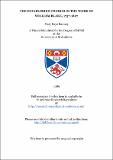Files in this item
The Established Church in the work of William Blake, 1757-1827
Item metadata
| dc.contributor.author | Ramsey, Mary Kaye | |
| dc.coverage.spatial | 231 p. | en_US |
| dc.date.accessioned | 2018-07-06T09:10:19Z | |
| dc.date.available | 2018-07-06T09:10:19Z | |
| dc.date.issued | 1989-07 | |
| dc.identifier.uri | https://hdl.handle.net/10023/15028 | |
| dc.description.abstract | Although the body of the critical work on William Blake's theology is vast, critics have overlooked the most obvious source of the poet's religious vision: the eighteenth-century Church of England. Throughout Blake's poetry, the Established Church plays a significant role. The early poetry seems to accept and to echo Church doctrine, often incorporating orthodox concepts and symbols. As Blake's disaffection with the Church-especially with the lethargic and corrupt clergy--become more pronounced, the Church assumes the character of the harlot of Babylon, or of the Archfiend, Satan. Even during this period, however, Blake does not reject the religion of Christ; his antipathy is for organized religion, for the Church. To Blake, the Church is no longer the Bride of Christ; she has become the whore of the state, the vassal of natural religion. Her character, inextricably intertwined with Man's Fall and fallen condition, is the subject of this study. This work is dedicated to Bill, Bob and Mary Ellen, for reasons understood but unexpressed. | en_US |
| dc.language.iso | en | en_US |
| dc.publisher | University of St Andrews | |
| dc.subject.lcc | PR4147.C5R2 | |
| dc.subject.lcsh | Blake, William, 1757-1827--Religion | en |
| dc.subject.lcsh | Religion in literature | en |
| dc.subject.lcsh | Established churches--England | en |
| dc.title | The Established Church in the work of William Blake, 1757-1827 | en_US |
| dc.type | Thesis | en_US |
| dc.type.qualificationlevel | Masters | en_US |
| dc.type.qualificationname | MPhil Master of Philosophy | en_US |
| dc.publisher.institution | The University of St Andrews | en_US |
This item appears in the following Collection(s)
Items in the St Andrews Research Repository are protected by copyright, with all rights reserved, unless otherwise indicated.

